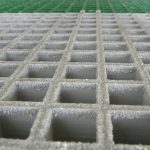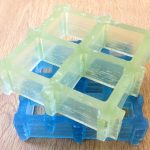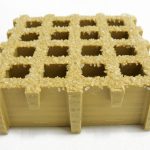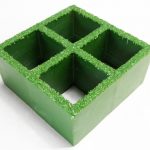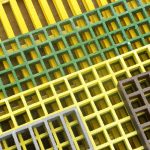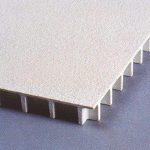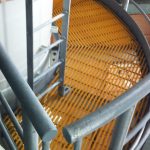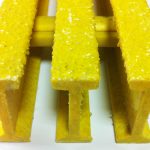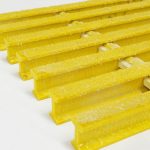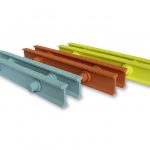Despite the huge variety of resin and glass-fibre choices available; there are predominately two categories of GRP grating:
Moulded Grating
Core6 moulded grating is manufactured by laying continuous glass fibres reinforcements into a mould, in a vertical and horizontal direction which are then thoroughly wetted out with a thermosetting polyester or vinyl ester resin, layer by layer. During the ‘weaving’ process glass-fibre reinforcements are compressed under weight to ensure the glass is thoroughly compacted and therefore allowing the glass content to be approximately 35% of the products final weight. When the weaving process is completed, the mould is cooled to cure the panel. After curing the panel is inspected, touched-up if necessary and, if a grit top surface is required, put through a horizontal belt-sander to gain a smooth top surface to allow a silica quartz grit to be applied.
- Translucent/Coloured Mesh
- 30mm Mini-Mesh Moulded Grating
- 50mm Moulded Grating
- Moulded Gratings
- Covered Moulded Grating
Pultruded Grating
Our Core6 GRP Pultruded grating offers a fast, safe and effective flooring solution to high load capacity access areas. Pultruded grating is manufactured by pulling (hence Pul-truded) glass-fibre reinforcement through a thermosetting polyester or vinyl ester resin bath. The thoroughly ‘wetted-out’ fibres are then fed through a pre-formed (and heated) steel die to achieve the shape of the tool.
There are generally two to three components to a pultruded grating, 1) the Load Bearing Bar and 2) the Tie (or Cross) Bars. These are cross-bars are generally from two different shapes to ensure an interlocking mechanism can be achieved.
The Load bearing bars are drilled at approx. every 150mm centres to accommodate the interlocking tie bars. The tie-bars are then fed through the load bars in a jig and bonded together to make the finished panel of grating.
If a gritted top surface is required the cured panel is then sealed with resin on the top and a coating of silica quartz grit is applied, then left to cure before a final secondary resin coat is applied to cover and seal in the grit.
This manufacturing process produces parts that are generally 65% fibreglass and 35% resin (by weight). As a result, this process produces the strongest composite gratings which are often specified in high traffic areas.
- Pultruded Grating
- 38mm Pultruded Core-6 GRP Grating
- Pultruded Core-6 GRP Grating
- Pultruded Core-6 GRP Grating
- T-Bar Wheelchair friendly Core-6 GRP Pultruded Grating
- T-Bar Wheelchair friendly Core-6 GRP Pultruded Grating
Data Sheets
Core-6 GRP Pultruded Grating Data Sheet
How to Choose GRP Grating
| Moulded Grating | Pultruded Grating | Steel Grating | |
|---|---|---|---|
| Corrosion resistant | Y | Y | N |
| Slip resistant | Y | Y | Some |
| Light weight (GRP Density 4 times less than steel) | Y | Y | N |
| Low maintenance | Y | Y | Y |
| Non-conductive | Y | Y | N |
| Radio Frequencies (FR) and Electromagnetic transparency | Y | Y | N |
| Aesthetic appealing | Y | Y | N |
| Impact resistant | Y | Y | N |
| UV resistant | Y | Y | Y |
| Easy to cut and fabricated | Y | Y | N |
| Bi-Directional Strength | Y | N | Some |

 Oil & Gas
Oil & Gas Rail
Rail Marine
Marine Civil &
Civil & Process &
Process & Power &
Power &